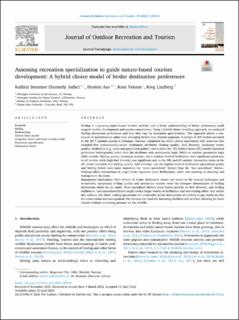| dc.contributor.author | Stemmer, Kathrin | |
| dc.contributor.author | Aas, Øystein | |
| dc.contributor.author | Veisten, Knut | |
| dc.contributor.author | Lindberg, Kreg | |
| dc.date.accessioned | 2023-06-14T13:27:33Z | |
| dc.date.available | 2023-06-14T13:27:33Z | |
| dc.date.created | 2022-04-26T16:52:00Z | |
| dc.date.issued | 2022-04-23 | |
| dc.identifier.citation | Journal of Outdoor Recreation and Tourism. 2022, 39 . | en_US |
| dc.identifier.issn | 2213-0780 | |
| dc.identifier.uri | https://hdl.handle.net/11250/3071368 | |
| dc.description | Published by Elsevier Ltd. This is an open access article under the CC BY license (http://creativecommons.org/licenses/by/4.0/). | en_US |
| dc.description.abstract | Birding is a growing nature-based tourism activity, and a better understanding of birder preferences could support tourism development and species conservation. Using a hybrid choice modeling approach, we analyzed birding destination preferences and how they vary by recreation specialization. This approach allows a continuum of specialization rather than allocating birders into discrete segments. A sample of 205 birders recruited in the 2017 summer season in Varanger, Norway, completed an online choice experiment with scenarios that included five systematically-varied destination attributes: Birding quality, bird diversity, landscape scenic quality, facilitation (e.g., trails and specialized guides), and a visitor fee. The hybrid choice (HC) model explained preference heterogeneity better than the attributes only multinomial logit (MNL) or random parameters logit (RPL) models. Birding quality, landscape scenery, and a medium level of facilitation were significant predictors in all models, while high bird diversity was significant only in the RPL and HC models. Interaction terms in the HC model indicated that birding quality, bird diversity, and the highest level of facilitation (specialized guides and birding hides) were more important for “more specialized” birders than for “less specialized” birders. Findings allow destinations to target birder segments more deliberately, while also assisting in planning and management decisions. | en_US |
| dc.description.abstract | Assessing recreation specialization to guide nature-based tourism development: A hybrid choice model of birder destination preferences | en_US |
| dc.language.iso | eng | en_US |
| dc.publisher | Elsevier | en_US |
| dc.rights | Navngivelse 4.0 Internasjonal | * |
| dc.rights.uri | http://creativecommons.org/licenses/by/4.0/deed.no | * |
| dc.subject | Birding | en_US |
| dc.subject | Birdwatching | en_US |
| dc.subject | Hybrid choice model | en_US |
| dc.subject | Integrated choice and latent variable model | en_US |
| dc.subject | Recreation specialization | en_US |
| dc.subject | Destination choice | en_US |
| dc.title | Assessing recreation specialization to guide nature-based tourism development: A hybrid choice model of birder destination preferences | en_US |
| dc.title.alternative | Assessing recreation specialization to guide nature-based tourism development: A hybrid choice model of birder destination preferences | en_US |
| dc.type | Journal article | en_US |
| dc.type | Peer reviewed | en_US |
| dc.rights.holder | © 2022 The Authors. | en_US |
| dc.source.articlenumber | 100516 | en_US |
| dc.description.version | publishedVersion | en_US |
| cristin.ispublished | true | |
| cristin.fulltext | original | |
| cristin.qualitycode | 1 | |
| dc.identifier.doi | 10.1016/j.jort.2022.100516 | |
| dc.identifier.cristin | 2019293 | |
| dc.source.journal | Journal of Outdoor Recreation and Tourism | en_US |
| dc.source.volume | 39 | en_US |
| dc.source.issue | September 2022 | en_US |
| dc.source.pagenumber | 1-10 | en_US |
| dc.relation.project | Norges forskningsråd: 255271 | en_US |

